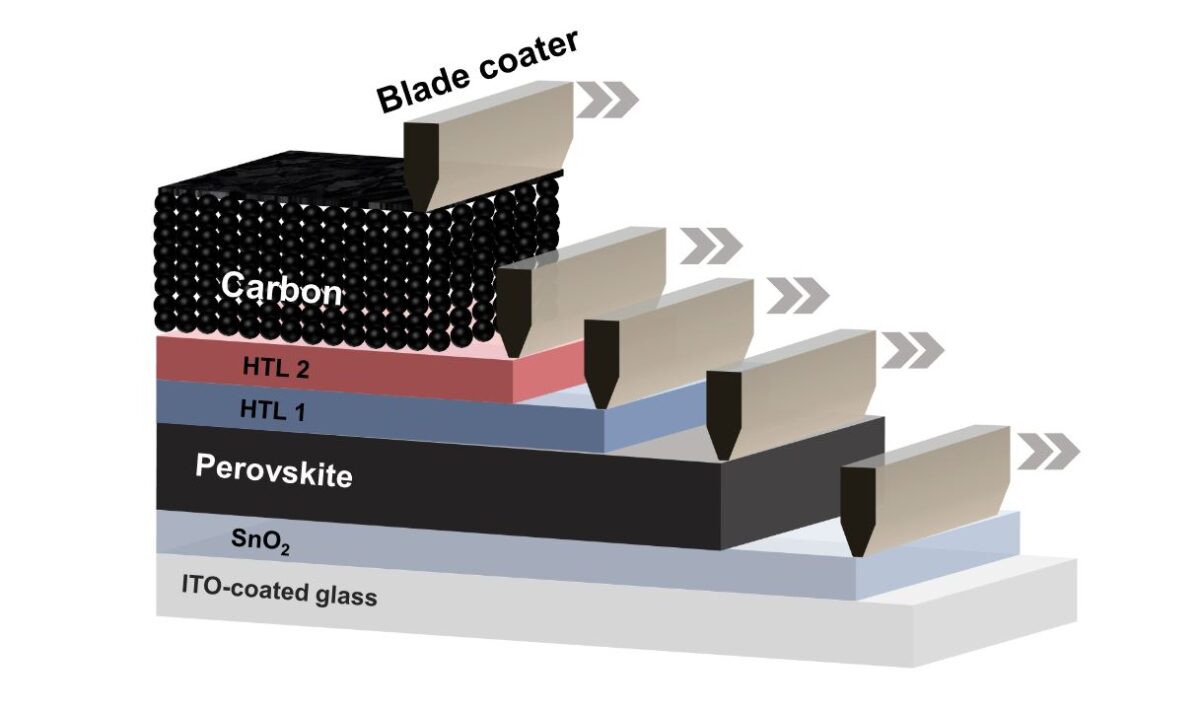Researchers in Germany have sought to improve the performance of carbon electrode perovskite solar cells through a hole-transporting bilayer made of organic semiconductors, instead of a conventional hole transport layer (HTL), which they said is able to enhance their fill factor and open-circuit voltage.
They explained that replacing costly gold, silver, and copper with carbon in perovskite solar cells typically causes efficiency losses and stability issues compared to benchmark devices. “For the printable cells, we aim at eventually transferring this technology into a roll-to-roll fabrication line,” Tian Du, corresponding co-author told pv magazine, noting that the next steps on the path to commercialization are to fabricate a mini solar module on glass substrates, then a mini solar module on flexible substrate, and then transfer to roll-to-roll fabrication.
The German team built the cell with a substrate made of glass and indium tin oxide (ITO), an electron transport layer (ETL) based on tin(IV) oxide (SnO2), the perovskite absorber, the hole-transporting bilayer (HTbl), and the carbon contact. “The HTbL configuration forms an energy cascade at the interface, with the outer HTL 2 reinforcing Ohmic contact with the carbon, whereas the inner HTL 1 reduces surface
recombination of the perovskite,” it explained.
For the absorber, they used a mix cation perovskite known as (FAPbI3)0.93 (MAPbBr 3)0.07. They applied the two layers in sequential blade coating which they said can maximize hole injection/extraction at the electrode interface while minimizing surface recombination of perovskite layers.
They tested the device under standard illumination conditions and found it achieved a power conversion efficiency of 19.2%, an open-circuit voltage of 1.11 V, a short-circuit current of 23.7 A, and a fill factor of 76%. For comparison, a reference cell with a single hole transport layer reached an efficiency of 17.3%, an open-circuit voltage of 1.06 V, a short-circuit current of 23.3 A, and a fill factor of 76%.
The cell based on the bilayer also showed stable operation of 2,500 h at 65 C in a nitrogen environment.
The cell is described in the study “Efficient, stable, and fully printed carbon-electrode perovskite solar cells enabled by hole-transporting bilayers,” published in Joule. The research team comprises academics from the Institute of Materials for Electronics and Energy Technology (i-MEET) and the Institute of Micro- and Nanostructure Research & Center for Nanoanalysis and Electron Microscopy (CENEM).
“Our results highlight that carbon electrodes can significantly enhance the intrinsic stability of perovskite solar cell without dedicated interfacial modifications,” they concluded.
This content is protected by copyright and may not be reused. If you want to cooperate with us and would like to reuse some of our content, please contact: editors@pv-magazine.com.



2 comments
By submitting this form you agree to pv magazine using your data for the purposes of publishing your comment.
Your personal data will only be disclosed or otherwise transmitted to third parties for the purposes of spam filtering or if this is necessary for technical maintenance of the website. Any other transfer to third parties will not take place unless this is justified on the basis of applicable data protection regulations or if pv magazine is legally obliged to do so.
You may revoke this consent at any time with effect for the future, in which case your personal data will be deleted immediately. Otherwise, your data will be deleted if pv magazine has processed your request or the purpose of data storage is fulfilled.
Further information on data privacy can be found in our Data Protection Policy.